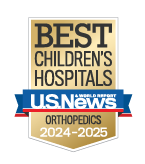Patellofemoral Pain Syndrome (Runner’s Knee)
Patellofemoral pain (runner’s knee) is a common knee problem. Growing athletes with this condition feel pain under and around the kneecap. The patellofemoral joint is made of the patella (kneecap), femur (thigh bone), and soft tissue supporting structures (patellar ligaments, bursae and tendons). The pain usually comes from these supporting structures.
What causes patellofemoral pain syndrome?

For most growing athletes with patellofemoral pain syndrome, there are a collection of factors that cause the pain. Anything that increases the strain on the soft tissue supporting structures around the kneecap can lead to a problem with how the kneecap moves through its groove in the thigh bone as you bend and straighten the knee.
Patellofemoral pain syndrome can also result from direct trauma such as falling onto the kneecap or hitting the knee. It most commonly occurs from overuse of the knee in sports or activities that involve intense and repetitive running and jumping.
Activities of daily living such as prolonged sitting or standing, and going up and down steps, create extra pressure between the kneecap and the femur causing more stress and irritation. Some variants of normal hip, knee and foot alignment can put additional strain on the patellofemoral joint and supporting structures.
Growing athletes who are “flat-footed,” “knock-kneed,” or “pigeon-toed” tend to have higher rates of patellofemoral pain syndrome. Weak hip and thigh muscles are an important cause of patellofemoral pain. These muscles support the kneecap. When they are weak, the kneecap will not glide smoothly through its groove. This increases the strain on the kneecap’s supporting structures which causes pain.
A tight IT band (a tendon that runs along the outside of your thigh from your hip to your shin bone) is another risk factor for patellofemoral pain since it also helps to control the movement of the kneecap in its groove.
Finally, tight hamstrings are a frequent cause of patellofemoral pain, especially in growing bodies. Since muscles grow faster than bones, it is common for larger muscles to become relatively tight during growth spurts. Tight hamstrings increase the pressure behind the kneecap, which can lead to pain.
What are the symptoms of patellofemoral pain syndrome?
The most common symptoms are pain during and/or after activity and pain or stiffness after prolonged sitting or standing. There may also be a grinding or popping feeling under the kneecap, and some people may experience mild swelling. The pain is usually dull and achy and may shift from one side of the kneecap to the other. Growing athletes may have pain in both knees or only in one knee. The pain is usually worse when kneeling, walking downhill or going up and down stairs.
How is patellofemoral pain syndrome diagnosed?
A sports medicine physician will review your growing athlete's symptoms and examine their knee. X-rays, MRIs and other imaging studies are not valuable in diagnosing patellofemoral syndrome but may be helpful to rule out other sources of knee pain.
How is patellofemoral pain syndrome treated?
- Treatment includes temporarily reducing irritating activities until the pain is better controlled. For example, you might want to bike or swim instead of run.
- The mainstay of treatment is a customized physical therapy program to strengthen and stretch the hip and thigh muscles so that they can help the kneecap move smoothly through its groove.
- Ice often helps to reduce the pain. Ice should be applied for no more than 15 minutes at a time and can be used as often as every hour.
- Anti-inflammatory medications, such as ibuprofen are typically not very helpful except when there is swelling.
- A sports medicine physician may recommend shoe inserts if you have flat feet that are contributing to the knee pain.
- A patellofemoral brace can provide support to the kneecap and may reduce pain during activity.
When can my child return to activities and sports after patellofemoral pain syndrome?
The goal of treatment is for your growing athlete to return to their activity or sport as soon as it is safely possible. Everyone recovers from injury at a different rate. Return to activity or sport will be determined by how soon your child's knee recovers, not by how many days or weeks it has been since the pain started. In general, the longer your child has symptoms before the start of treatment, the longer it will take to get better.
Your growing athlete may begin to return safely to their activity when each of the following is true:
- Your child can fully straighten and bend their knee without pain
- Swelling is resolved
- Your child's knee and leg have normal strength and flexibility
- Your child can walk and perform daily activities without pain
- Your child can jog straight without limping and without pain
- Your child can jump on both legs without pain and jump on the injured leg without pain
How can my child prevent patellofemoral pain syndrome?
- Maintain strong and flexible thigh and hip muscles
- Make sure your growing athlete wears shoes that fit well, have good support and are appropriate for the activity
- Begin any new activity slowly and increase the intensity, duration, and frequency gradually. (Runners should increase their mileage by no more than 10% per week)
- Do not play through significant knee pain. If pain persists despite rest for a few days, see your sports medicine physician
- Injury Management
- Ankle Injuries
- Athletic Training
- Concussion Treatment
- Gymnast Wrist
- Hockey Injuries
- Human Performance Lab
- Mental Wellness
- Meet the Sports Medicine Team
- Osteochondritis Dissecans (OCD)
- Patella Tendonitis (Jumper’s Knee)
- Patellofemoral Pain Syndrome (Runner’s Knee)
- Sports Medicine Center
- Sports Physical Therapy
- 360° Tour of Village West